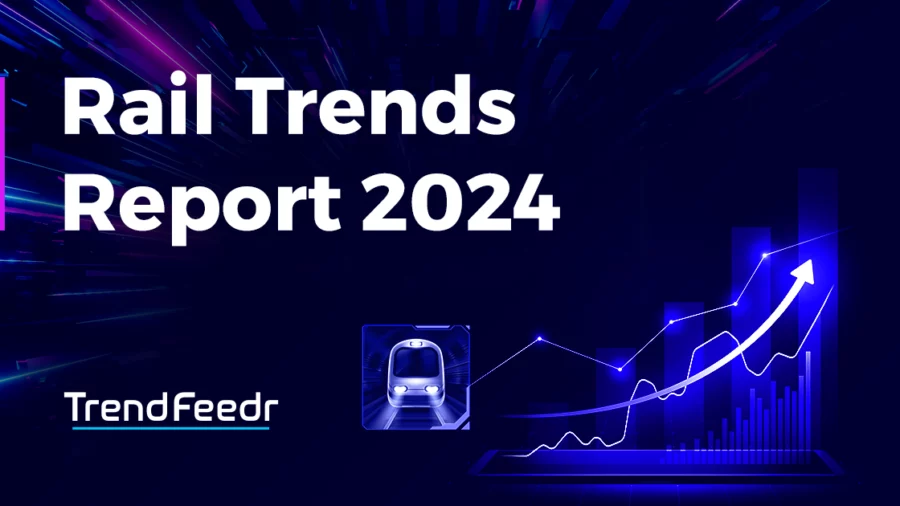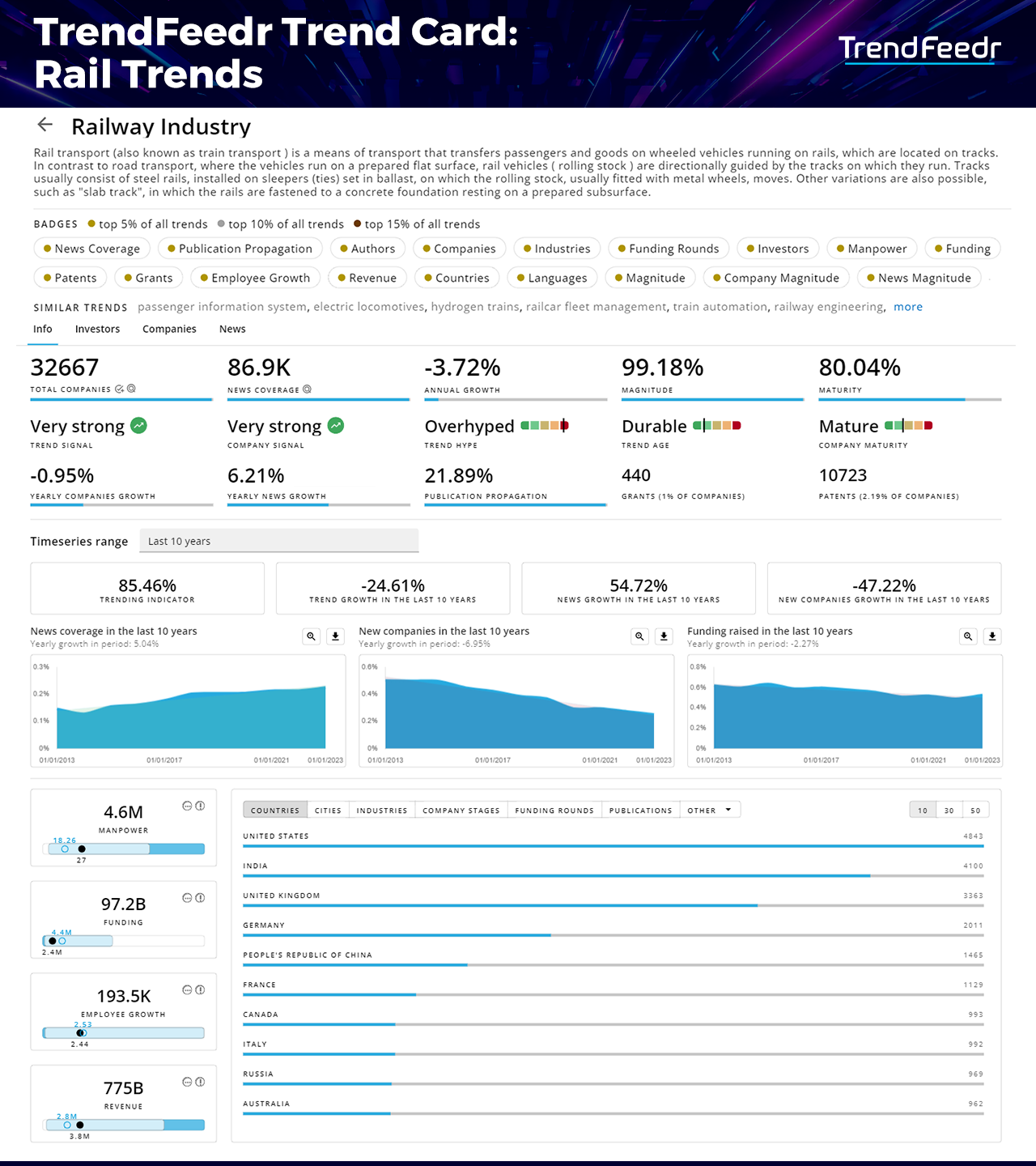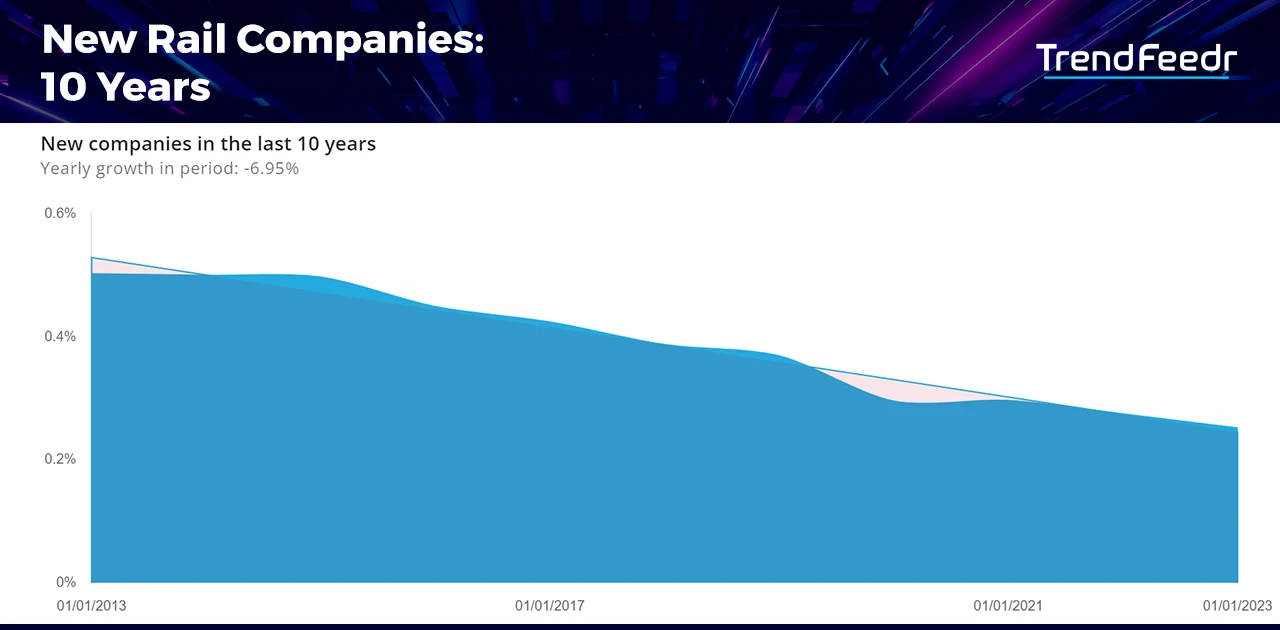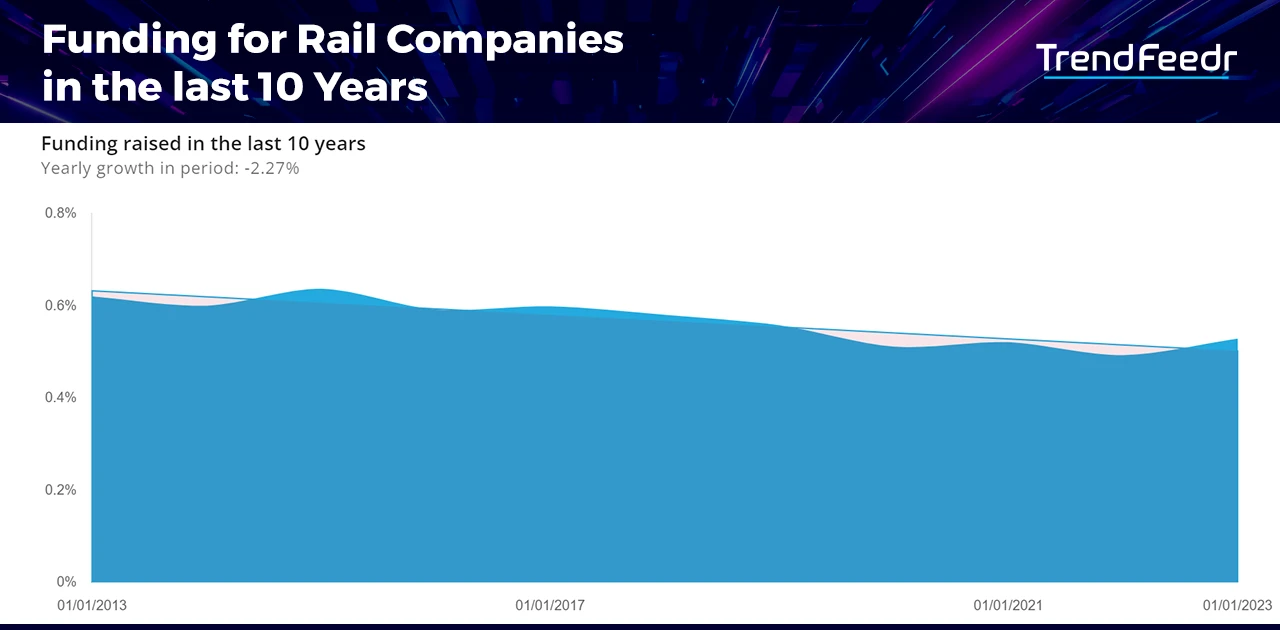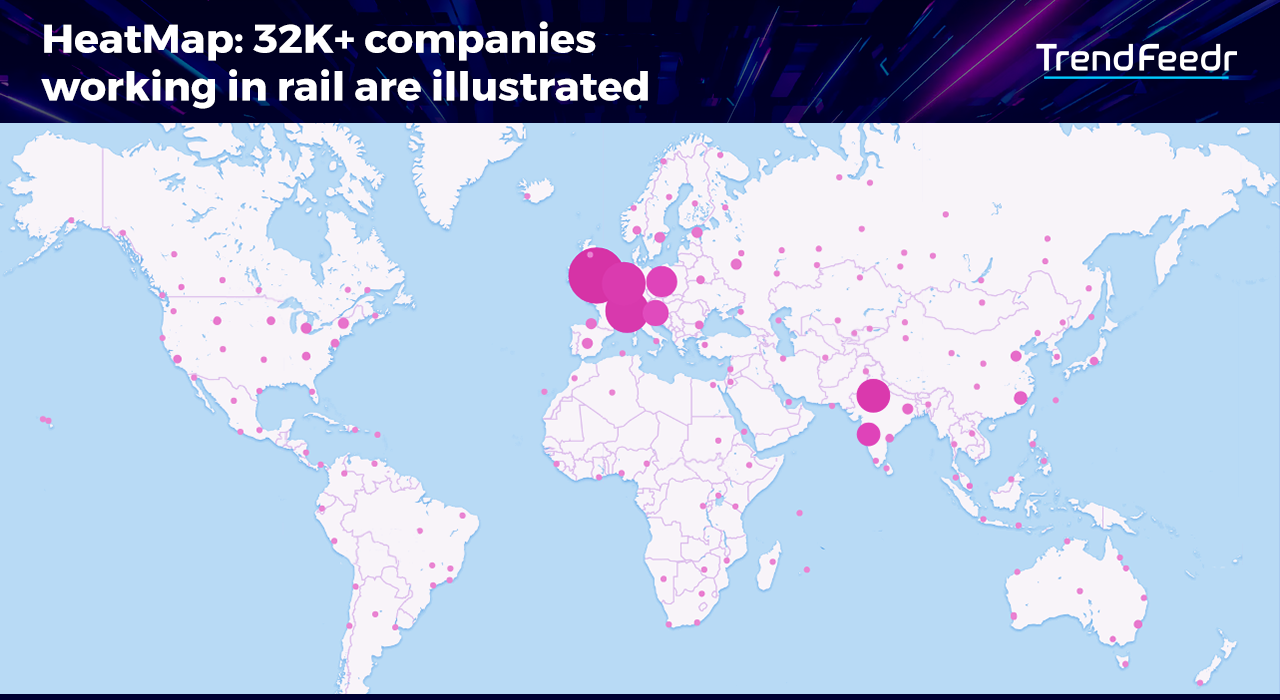As the railway industry is undergoing a transformation, driven by technological innovation and sustainability goals, this rail trends report highlights key changes and their role in shaping the future of mass transit. Digital solutions, such as artificial intelligence (AI) and the Internet of Things (IoT), enhance the efficiency and safety of rail travel. Other solutions like passenger information systems, electric locomotives (aka electric trains), hydrogen trains, and more are gathering interest from the industry. These trends also represent a critical step toward minimizing the environmental impact of rail transportation, setting new standards for ecological responsibility in the rail sector.
Focusing on the rail market trends, the data shows a strong growth trajectory for the global railway system market. According to Allied Market Research, the market is expected to grow from US$27.2 billion in 2021 to US$42.4 billion by 2031. This growth represents a compound annual growth rate of 4.6% from 2022 to 2031.
Key Takeaways
- Dominant Trend: According to TrendFeedr, with a trend magnitude of 99.18% and a trend maturity of 80.04%, the rail industry is crucial for the global economy.
- Rail Advancements: Rail companies are expanding their focus to include cutting-edge trends such as passenger information systems, electric trains, hydrogen trains, railcar fleet management, and train automation.
- Robust News Coverage: News coverage of the rail industry has seen a consistent annual growth of 5.04% over the last decade, highlighting increasing public interest in its developments.
- Growing Industrial Participation: Approximately 32,000 organizations are participating in the rail industry, collectively attracting investment capital of around US$97.2 billion.
- Major Investors including Wabtec Corporation and Goldman Sachs are infusing billions into pioneering rail ventures, showcasing their belief in the industry’s role in shaping future transportation.
- Global Rail Hotspots: Leading countries in rail innovation include the United States, India, the United Kingdom, Germany, and China. Key cities like London, New York City, Mumbai, New Delhi, and Moscow are emerging as hubs for rail technology development and implementation.
Table of Contents
- Understanding Rail Trends
- Rail Trend Card
- Emerging Trends & Technologies
- 5 Key Rail Trends
- 5 Emerging Rail Companies
- Rail Investment Trends
- Mapping Global Rail Companies
- Media Coverage for the Rail Industry
- Future of Railroads
For this detailed railway trends analysis, we leveraged TrendFeedr, our all-in-one trend intelligence platform. TrendFeedr uses advanced algorithms to identify future industry and emerging tech trends. With a focus on trend discovery, clustering, and analysis, the AI-powered platform reviews thousands of trends each week to provide actionable insights.
Among more than 20,000 trends and technologies monitored by TrendFeedr, the rail industry has made a notable impact. Here’s why:
- The rail industry ranks within the top 150 trends, placing it in the top 1% of global trends. This ranking underscores its crucial role in sustainable mass transportation and global freight movement.
- With a trend maturity of 80.04%, the rail industry is dominated by mature organizations that drive its growth and technological evolution.
- The sector enables eco-friendly transit and cargo transport. It also shapes urban development and connects global markets, thereby supporting economic growth and international trade.
In this rail trends report, let’s explore performance, investment, regional impact, and future outlook.
Understanding Rail Trends
Let’s examine the driving forces behind the ongoing transformation in the rail industry. We focus on pivotal trends and innovative technologies that are redefining efficiency, sustainability, and passenger experience.
What are trends in the railway industry?
The railway industry is witnessing a shift towards sustainable and environmentally friendly solutions, such as the adoption of electric and hydrogen-powered trains. These alternatives significantly reduce carbon emissions compared to traditional diesel engines. Concurrently, the development of high-speed rail networks is gaining momentum. Countries like China, Japan, and those in the European Union are expanding their networks, reducing travel times, and competing with air travel for long-distance journeys.
The industry is also leveraging the IoT and AI to develop smart railway systems. These systems enhance operational efficiency, improve safety, and provide real-time data analytics for better decision-making and maintenance. Lastly, there’s a growing focus on improving the passenger experience through enhanced amenities, connectivity, and information systems, making rail travel more comfortable and convenient.
What are emerging technologies in the railway industry?
AI and machine learning are emerging technologies in the railway industry, used for predictive maintenance, route optimization, and enhancing security systems. These technologies are crucial for minimizing downtime and ensuring passenger safety. Further, IoT enables real-time monitoring of equipment, tracks, and trains, leading to improved asset management and more reliable services.
Automation is also on the rise, paving the way for semi-autonomous and autonomous trains, which reduce the need for human intervention and increase efficiency. Blockchain is enhancing security and transparency in ticketing systems, cargo tracking, and supply chain management. Lastly, Augmented reality (AR) aids in maintenance operations and staff training by offering interactive and detailed insights into complex systems without the need for physical components.
Rail Trend Card: Explore the Most Recent Developments in the Railway Industry
Our Rail Trend Card presents a comprehensive overview of the rail industry’s robust dynamics:
Looking for all trends related to the rail industry?
- Rail Market Dynamics: The industry, comprising 32,667 entities, exhibits a strong company signal. With a yearly decline of -6.95% in annual company growth, the rail sector needs to adapt to the changing market conditions.
- Market Health Indicators: Although the industry has seen an annual growth decline of -3.72%, it remains resilient with a trend magnitude of 99.18% and a maturity level of 80.04%.
- Innovation and Knowledge Sharing: The industry is adopting innovation and accelerating research, with 440 grants and 10,723 patents granted.
- Human and Financial Capital: The sector employs 4.6 million people and has a funding pool of US$97.2B, demonstrating its capacity for growth and innovation.
- Global Reach: The United States, India, the United Kingdom, Germany, China, and France are leading in the industry’s global advance.
- Employee Growth & New Ventures: The sector shows an annual employee growth of 193.5K, but a decline in new companies, signaling a phase of consolidation and scaling among existing players.
- News Sentiment & Coverage: There’s a significant buzz with 86.9K news pieces covering the rail industry. The trend hype remains moderate, suggesting a focus on quality and sustainable growth.
Learn more about these metrics as we continue to explore rail trends.
How Do Emerging Technologies Disrupt the Rail Industry?
The rail industry is at a crucial crossroads, with innovative trends and technological advancements transforming transportation. This sector is adopting new strategies to improve environmental sustainability, operational efficiency, and global connectivity. Let’s delve into these developments:
1. Passenger Information Systems
Passenger information systems utilize GPS and AI to enrich travel experiences. These systems provide real-time updates on train schedules, delays, and platform changes. Further, employing advanced analytics allows for customized information displays, enhancing commuter awareness and safety. This revolutionizes rail travel by prioritizing passenger convenience and making information more accessible.
Companies such as TrainFX provide passenger information systems for both new and retrofitted trains. Its offerings include a range of products such as LED or LCD screens, a real-time passenger information system controller, and call-for-assistance modules. The startup facilitates systems management, integrating operations, route planning, and maintenance through a web interface. Further, it also supports real-time tracking of trains.
2. Electric Locomotives
Electric locomotives – or electric trains – represent a shift toward sustainable transportation. It uses advanced electric motors, reducing fossil fuel dependence and environmental impact. These locomotives feature regenerative braking systems with a streamlined and lightweight design, leading to higher speeds and lower maintenance costs.
For instance, Varamis utilizes fully electric trains for rapid, environmentally friendly supply chain transportation, achieving zero emissions. Goods are consolidated and loaded at city center train stations, then transported to city center logistics hubs for onward distribution.
3. Hydrogen Trains
Utilizing hydrogen fuel cells, hydrogen trains generate electrical power, with only water vapor and heat as byproducts. Excess energy is stored in batteries, optimizing energy use during journeys. Moreover, these trains offer quieter operation and faster acceleration than traditional models.
Startups such as BeHydro manufacture heavy-duty hydrogen combustion engines for use in locomotives. BeHydro provides customized solutions for both new and repowered shunting and mainline service locomotives. Both, the dual-fuel and 100% hydrogen variants of the startup, offer zero-emission operations, significantly reducing the CO2 footprint.
4. Railcar Fleet Management
Railcar fleet management leverages the IoT, big data, and advanced analytics to enhance operational efficiency. This strategy allows for real-time tracking of railcar locations, monitoring conditions, and scheduling maintenance. Further, it provides insights into usage patterns, enabling optimal fleet allocation and minimizing downtime.
Vontas, for example, specializes in advanced fleet management solutions for railcars. The platform enables operators to perform essential functions like logging in, making announcements, and collecting fares. The startup’s system features remote monitoring, enabling continuous operation tracking via a cloud-based dashboard.
5. Train Automation
Automated trains use sensor-based systems for precise speed and route control, minimizing human error and thus accidents. Additionally, automation brings about safety features like obstacle detection and automatic braking to enhance the overall safety of the rail network. Because train automation enables autonomous operation, it cuts labor costs and enhances scheduling flexibility.
Startups such as OTIV enhance rail operations in challenging environments through a range of advanced systems. Its offerings include an assistance system for industrial shunting. In this context, it provides safe and efficient movements with full control through real-time, AI-optimized views. It also offers an advanced driver assistance system (ADAS) for mainline and urban environments, equipped with sensors and algorithms like LiDAR and AI.
Key Rail Trends & Firmographic Insights
The rail industry employs a workforce of 4.6 million individuals worldwide. The average company size is 200 employees, suggesting the presence of both large entities and medium-sized enterprises in the sector. The median figure of 27 indicates that many rail companies are likely small to medium-sized operations, crucial for a diverse and resilient industry ecosystem.
The annual employee growth provides additional insight: with a total increase of 193.5K employees, the rail industry is actively growing. The average yearly company growth is 10 employees with a median of 2. Despite the overall number of companies decreasing, the workforce within existing companies is expanding. This could be due to increasing automation and technology adoption, requiring more skilled personnel.
Let’s look at the five key trends we discussed earlier in detail. Here are the insights into the number of rail companies involved, the total investment, and the workforce engaged in each of these trends.
1. Passenger Information Systems
- They improve communication with passengers by delivering real-time travel information, alerts, and announcements both on-board trains and at stations.
- A total of 286 organizations are active in this sector, collectively amassing a significant US$932.7 million in funding.
- Powered by a robust workforce of 31.1K individuals, these organizations are redefining the passenger experience in rail travel.
2. Electric Locomotives
- Electric locomotives reduce environmental impact and operating costs in rail transport, offering a cleaner alternative to diesel-powered trains.
- 191 organizations are working in this area, with a collective funding of US$300.7 million.
- With a strong workforce of 143.2K individuals, these organizations are leading the charge towards sustainable rail transport.
3. Hydrogen Trains
- Hydrogen trains harness hydrogen fuel cells for propulsion, thereby reducing environmental pollution.
- 93 organizations are delving into this trend, with a total funding of US$6.4 billion.
- Driven by a dedicated team of 13.9K individuals, these organizations are paving the way for a cleaner and greener future in rail transport.
4. Railcar Fleet Management
- Employing railcar fleet management optimizes the use, maintenance, and scheduling of railcars.
- A total of 63 organizations are working in this area, with a collective funding of US$4.6 billion.
- With a workforce of 19K individuals, these organizations are optimizing rail operations and logistics.
5. Train Automation
- Implementing train automation improves the safety, efficiency, and reliability of rail services.
- 1,772 organizations are exploring this sector, with a total funding of US$6.3 billion.
- Supported by a team of approximately 106K individuals, these organizations are shaping the future of autonomous rail travel.
5 Emerging Rail Companies
The time series chart reveals an annual decrease of -6.95% in new rail companies founded over the past ten years. This data suggests an ongoing consolidation phase within the rail industry. Instead of welcoming new players, the industry seems to prioritize the growth and strengthening of existing companies. This pattern indicates a potential increase in entry barriers, likely due to the substantial capital needs and intricate regulatory frameworks inherent to the rail sector.
5 Promising Rail Startups
Rail startups are accelerating the rail industry’s evolution, offering innovative solutions that fuel and transform rail transport. These startups are leveraging advanced rail infrastructure technologies and data-driven maintenance systems. They are also introducing eco-friendly propulsion methods and smart ticketing solutions. These innovations address the intricate challenges of efficiency, safety, and sustainability in rail transportation. In the following section, we will explore five rail startups established in the past six years and their contributions to the future of rail travel:
- RailSense offers smart sensors and an intelligence platform to measure rail infrastructure asset performance.
- RailEvo introduces an innovative on-demand transportation system, featuring autonomous electric rail vehicles and a dedicated railway network.
- CEMIT offers an AI data platform that merges analysis and visualization tools, providing a comprehensive view of anomaly detection in the railway industry.
- Wirail, an IoT startup, focuses on the development of smart monitoring devices for freight rail industries.
- RAILwAI develops a platform to optimize the management of railway infrastructure maintenance and operations.
Rail Investment Trends
The rail industry’s financial robustness is clear, as it ranks within the top 5% of all 20K+ trends and technologies monitored by TrendFeedr.
The total capital raised by rail companies has experienced a minor decrease, with an annual drop of 2.27% over the past decade. This pattern suggests a market that is becoming more discerning, potentially concentrating investments in ventures that are more promising and technologically advanced.
A Closer Look at the Financials
According to TrendFeedr, the rail industry’s total funding stands at a remarkable US$97.2 billion. The highest funding recorded for a single entity is US$3.4 billion. Among the companies with substantial funding, Sqills is a notable one. On average, companies have raised US$55.2 million, with a median value of US$2.4 million, indicating a balanced distribution of investment across the sector.
In terms of revenue, TrendFeedr estimates the total revenue to be US$775 billion. The maximum revenue reported by a single company, Mir Akhter Hossain, is US$3.1 billion. The average revenue per company is approximately US$32.3 million, and the median is US$3.8 million, showcasing the industry’s substantial economic contribution and profitability potential.
A total of 5.39% of rail companies have received funding, underlining the selective allocation of investments. Mergers and acquisitions (M&A) often symbolize strategic growth and consolidation opportunities in the industry. Venture rounds are critical for the scaling phase of innovative rail startups. Initial public offerings (IPOs) or transitions to public company status signal maturity and stability. Seed funding is crucial for emerging companies with promising potential. Later-stage venture capital or series C funding rounds suggest companies preparing for significant expansion or market penetration.
Grants hold a unique position in the rail industry, with a total of 440 grants awarded, benefiting 1% of rail companies.
Prominent Investors in the Rail Industry
Wabtec Corporation has made substantial contributions totaling US$415.1 million across four companies, demonstrating its commitment to advancing rail technology and infrastructure. Its most notable investment includes US$112.5 million in Napier Turbochargers.
Goldman Sachs, with a total investment of US$411.7 million in four different companies, remains a key financier in the industry. It has allocated substantial funds, including US$250 million to BNSF Railway, highlighting targeted investment in companies with strong growth prospects.
Public investment also plays a crucial role in the rail industry’s growth, with a staggering US$4 billion invested across 121 companies. Top beneficiaries of public investment include China Railway Special Cargo Logistics, with an investment of US$272.4 million, and Chengdu Xinzhu Road & Bridge Machinery, receiving US$195.3 million. These investments in Chinese enterprises represent the nation’s commitment to enhancing its rail infrastructure.
Further, the variety of its unique investors ranks the rail industry in the top 5% of all trends for the total amount of funding received, showcasing the belief in the industry’s growth and future profitability.
Mapping Rail Companies Around the Globe
Our heatmap offers an exclusive view of the global rail industry, highlighting approximately 32,000 companies leading the charge in rail innovation.
The United States continues to be a powerhouse in the rail sector, its position strengthened by significant infrastructure investments and a solid industrial foundation. India is next in line, with its extensive rail network expansion and modernization initiatives indicating a marked uptick in rail company operations. The United Kingdom, with its strategic emphasis on rail innovation and sustainability, remains a key player. Germany’s meticulous engineering and advances in high-speed rail add to its substantial presence in the rail industry. China’s considerable investment in rail has also resulted in a proliferation of rail-related businesses, positioning it as a global front-runner in rail infrastructure development.
At the city level, London emerges as a nexus for rail companies, particularly in the spheres of finance and technological innovation within the sector. New York City’s ranking mirrors its involvement in both domestic and international rail-related commercial transactions. Additionally, Mumbai and New Delhi are at the epicenter of India’s rail industry surge, propelled by urban growth and public transport overhauls. Moscow’s significance is linked to Russia’s vast rail network and its strategic value for Eurasian land transport corridors.
Interested to explore all 32K+ rail companies?
Media Coverage for the Rail Industry Sees a Yearly Uptick of 5.04% Over the Last 10 Years
The time series chart indicates a consistent annual growth rate of 5.04% in news articles covering the rail industry over the past decade. This steady increase in media attention corresponds with the strategic expansions within the rail industry. Also, the initiation of innovative projects has garnered the interest of journalists and news outlets worldwide.
Moreover, the growth in publication coverage for the rail industry is significant, placing it within the top 5% of all trends. With a total of 86.9K articles published between 2005 and 2023, the rail industry also ranks in the top 5% of all trends in terms of content volume. This reflects the industry’s crucial role in shaping the future of transportation.
What is the Future of the Rail Industry?
Drawing from current data and the insights above, we can make several educated predictions about the trajectory of the rail sector. Here’s a future outlook for the rail industry:
Embracing Renewable Energy for a Greener Future
The rail industry is progressively concentrating on sustainable development, aiming to minimize its environmental impact. Efforts are being made to utilize renewable energy sources, such as solar and wind power, for train operations and infrastructure.
Moreover, the focus lies on creating more energy-efficient trains and reducing emissions through novel propulsion technologies. This transition aligns with worldwide environmental objectives and also offers long-term economic advantages for rail operators through decreased energy expenses and increased appeal to eco-conscious consumers.
Revolutionizing Transport with Smart Rail Infrastructure
The advent of intelligent rail infrastructure marks a significant advancement in the operation and interaction of rail systems with their surroundings. Through the integration of IoT sensors and sophisticated data analytics, rail networks are becoming more efficient and dependable.
These technologies facilitate real-time monitoring and predictive maintenance, reducing downtime and enhancing safety. Intelligent infrastructure also encompasses advanced signaling and communication systems, streamlining train movements and optimizing network capacity.
Transforming Mobility with the Integration of Autonomous Technology in Rail Systems
Autonomous trains, equipped with state-of-the-art sensors and AI algorithms, are expected to boost operational efficiency and safety. These systems optimize routes, speed, and energy consumption more effectively than trains operated by human workers.
Further, autonomous technology extends to rail maintenance, with the utilization of drones and robotic systems for inspecting and repairing tracks and infrastructure. This minimizes the need for human intervention in hazardous conditions.
Achieving Global Rail Connectivity for Unified Travel
Improving global connectivity is a crucial aspect of the rail industry’s future. This involves the expansion and upgrading of international rail links to facilitate cross-border transportation, bolstering global trade and tourism.
Initiatives such as transcontinental railways and international freight corridors are being developed to create seamless travel and transport routes. Enhanced connectivity also encompasses digital integration, where standardized information systems and digital platforms enable more efficient scheduling, tracking, and management of international rail services.
Dynamic Freight Rail Evolution for Efficient Supply Chain
The evolution of rail freight is vital in addressing the increasing demands of global trade. Innovations in this sector include the development of longer, heavier trains capable of transporting goods with greater efficiency.
Additionally, there is a focus on intermodal transport solutions, where rail systems integrate with other modes of transport like shipping and trucking. Modern freight rail also incorporates advanced logistics technologies, such as blockchain and AI-driven supply chain management. These technologies enhance tracking, scheduling, and overall operational efficiency in the movement of goods.
Rail Trends: Navigating the Future of Train Transportation
As we wrap up our rail trends report, it is clear that we are moving through a rapidly changing landscape. The pace of discoveries is fast, and the range of possibilities seems endless. Keeping up with these changing trends is very important. It allows you to anticipate changes, take advantage of new opportunities, and stay ahead in a field that is shaping the future of technology. But how do you do that?
Connect with rail industry enthusiasts, industry leaders, and innovative creators; their insights can provide valuable perspectives and open up opportunities for collaboration. Dive into rail market research reports, attend rail industry-focused seminars and conferences, and participate in online rail industry communities. Also, use trend-tracking tools, like TrendFeedr, that meticulously track up to 24 rail industry sub-trends, offering a comprehensive view of the evolving rail industry landscape.

